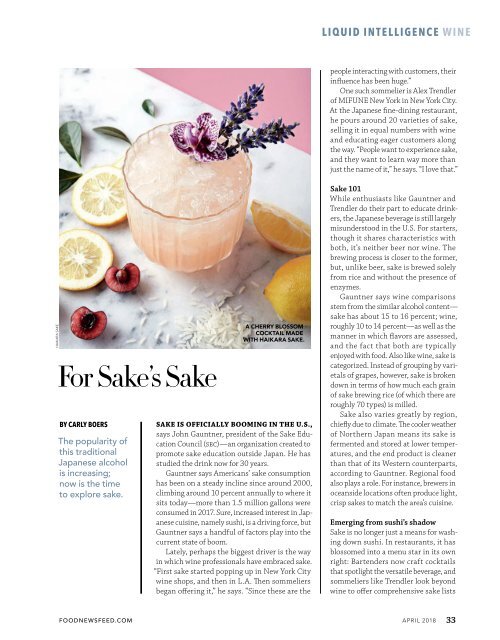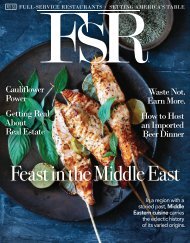FSR magazine April 2018
Create successful ePaper yourself
Turn your PDF publications into a flip-book with our unique Google optimized e-Paper software.
l iquid i ntelligenC e W ine<br />
people interacting with customers, their<br />
influence has been huge.”<br />
One such sommelier is Alex Trendler<br />
of MIFUNE New York in New York City.<br />
At the Japanese fine-dining restaurant,<br />
he pours around 20 varieties of sake,<br />
selling it in equal numbers with wine<br />
and educating eager customers along<br />
the way. “People want to experience sake,<br />
and they want to learn way more than<br />
just the name of it,” he says. “I love that.”<br />
Haikara Sake<br />
For Sake’s Sake<br />
By Carly Boers<br />
The popularity of<br />
this traditional<br />
Japanese alcohol<br />
is increasing;<br />
now is the time<br />
to explore sake.<br />
A cherry blossom<br />
cocktAil mAde<br />
with hAikArA sAke.<br />
Sake iS officially booming in the U.S.,<br />
says John Gauntner, president of the Sake Education<br />
Council (sec)—an organization created to<br />
promote sake education outside Japan. He has<br />
studied the drink now for 30 years.<br />
Gauntner says Americans’ sake consumption<br />
has been on a steady incline since around 2000,<br />
climbing around 10 percent annually to where it<br />
sits today—more than 1.5 million gallons were<br />
consumed in 2017. Sure, increased interest in Japanese<br />
cuisine, namely sushi, is a driving force, but<br />
Gauntner says a handful of factors play into the<br />
current state of boom.<br />
Lately, perhaps the biggest driver is the way<br />
in which wine professionals have embraced sake.<br />
“First sake started popping up in New York City<br />
wine shops, and then in L.A. Then sommeliers<br />
began offering it,” he says. “Since these are the<br />
Sake 101<br />
While enthusiasts like Gauntner and<br />
Trendler do their part to educate drinkers,<br />
the Japanese beverage is still largely<br />
misunderstood in the U.S. For starters,<br />
though it shares characteristics with<br />
both, it’s neither beer nor wine. The<br />
brewing process is closer to the former,<br />
but, unlike beer, sake is brewed solely<br />
from rice and without the presence of<br />
enzymes.<br />
Gauntner says wine comparisons<br />
stem from the similar alcohol content—<br />
sake has about 15 to 16 percent; wine,<br />
roughly 10 to 14 percent—as well as the<br />
manner in which flavors are assessed,<br />
and the fact that both are typically<br />
enjoyed with food. Also like wine, sake is<br />
categorized. Instead of grouping by varietals<br />
of grapes, however, sake is broken<br />
down in terms of how much each grain<br />
of sake brewing rice (of which there are<br />
roughly 70 types) is milled.<br />
Sake also varies greatly by region,<br />
chiefly due to climate. The cooler weather<br />
of Northern Japan means its sake is<br />
fermented and stored at lower temperatures,<br />
and the end product is cleaner<br />
than that of its Western counterparts,<br />
according to Gauntner. Regional food<br />
also plays a role. For instance, brewers in<br />
oceanside locations often produce light,<br />
crisp sakes to match the area’s cuisine.<br />
Emerging from sushi’s shadow<br />
Sake is no longer just a means for washing<br />
down sushi. In restaurants, it has<br />
blossomed into a menu star in its own<br />
right: Bartenders now craft cocktails<br />
that spotlight the versatile beverage, and<br />
sommeliers like Trendler look beyond<br />
wine to offer comprehensive sake lists<br />
FOODNEWSFEED.cOm april <strong>2018</strong> 33



